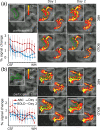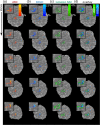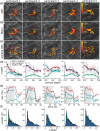Combining arterial blood contrast with BOLD increases fMRI intracortical contrast
- PMID: 36763562
- PMCID: PMC10028680
- DOI: 10.1002/hbm.26227
Combining arterial blood contrast with BOLD increases fMRI intracortical contrast
Abstract
BOLD fMRI is widely applied in human neuroscience but is limited in its spatial specificity due to a cortical-depth-dependent venous bias. This reduces its localization specificity with respect to neuronal responses, a disadvantage for neuroscientific research. Here, we modified a submillimeter BOLD protocol to selectively reduce venous and tissue signal and increase cerebral blood volume weighting through a pulsed saturation scheme (dubbed Arterial Blood Contrast) at 7 T. Adding Arterial Blood Contrast on top of the existing BOLD contrast modulated the intracortical contrast. Isolating the Arterial Blood Contrast showed a response free of pial-surface bias. The results suggest that Arterial Blood Contrast can modulate the typical fMRI spatial specificity, with important applications in in-vivo neuroscience.
Keywords: 3D-EPI; arterial blood contrast; cerebral blood volume; layer-dependent fMRI; magnetization prepared fMRI; ultrahigh field MRI.
© 2023 The Authors. Human Brain Mapping published by Wiley Periodicals LLC.
Conflict of interest statement
The authors declare no conflict of interest.
Figures









Similar articles
-
Non-BOLD contrast for laminar fMRI in humans: CBF, CBV, and CMRO2.Neuroimage. 2019 Aug 15;197:742-760. doi: 10.1016/j.neuroimage.2017.07.041. Epub 2017 Jul 20. Neuroimage. 2019. PMID: 28736310 Review.
-
Comparison of BOLD and CBV using 3D EPI and 3D GRASE for cortical layer functional MRI at 7 T.Magn Reson Med. 2020 Dec;84(6):3128-3145. doi: 10.1002/mrm.28347. Epub 2020 Jun 18. Magn Reson Med. 2020. PMID: 32557752 Free PMC article.
-
Modelling the depth-dependent VASO and BOLD responses in human primary visual cortex.Hum Brain Mapp. 2023 Feb 1;44(2):710-726. doi: 10.1002/hbm.26094. Epub 2022 Oct 3. Hum Brain Mapp. 2023. PMID: 36189837 Free PMC article.
-
Sensitivity and specificity considerations for fMRI encoding, decoding, and mapping of auditory cortex at ultra-high field.Neuroimage. 2018 Jan 1;164:18-31. doi: 10.1016/j.neuroimage.2017.03.063. Epub 2017 Mar 31. Neuroimage. 2018. PMID: 28373123 Free PMC article.
-
Biophysical and physiological origins of blood oxygenation level-dependent fMRI signals.J Cereb Blood Flow Metab. 2012 Jul;32(7):1188-206. doi: 10.1038/jcbfm.2012.23. Epub 2012 Mar 7. J Cereb Blood Flow Metab. 2012. PMID: 22395207 Free PMC article. Review.
Cited by
-
Cerebellar imaging for neuroscience at 9.4 T.Magn Reson Med. 2025 Nov;94(5):2129-2139. doi: 10.1002/mrm.30596. Epub 2025 Jun 28. Magn Reson Med. 2025. PMID: 40580510 Free PMC article.
-
Enabling brain-wide mapping of layer-specific functional connectivity at 3T via layer-dependent fMRI with draining-vein suppression.bioRxiv [Preprint]. 2024 Dec 23:2023.10.24.563835. doi: 10.1101/2023.10.24.563835. bioRxiv. 2024. PMID: 37961360 Free PMC article. Preprint.
-
Does the Cortical-Depth Dependence of the Hemodynamic Response Function Differ Between Age Groups?Brain Topogr. 2025 Feb 28;38(3):34. doi: 10.1007/s10548-025-01107-0. Brain Topogr. 2025. PMID: 40019567 Free PMC article.
-
Blood nulling versus tissue suppression: Enhancing integrated VASO and perfusion (VAPER) contrast for laminar fMRI.Imaging Neurosci (Camb). 2025 Jan 21;3:imag_a_00453. doi: 10.1162/imag_a_00453. eCollection 2025. Imaging Neurosci (Camb). 2025. PMID: 40800978 Free PMC article.
References
-
- Bottomley, P. A. , & Edelstein, W. A. (1981). Power deposition in whole‐body NMR imaging. Medical Physics, 8, 510–512. - PubMed
-
- Boxerman, J. L. , Bandettini, P. A. , Kwong, K. K. , Baker, J. R. , Davis, T. L. , Rosen, B. R. , & Weisskoff, R. M. (1995). The intravascular contribution to fMRI signal change: Monte Carlo modeling and diffusion‐weighted studies in vivo. Magnetic Resonance in Medicine, 34, 4–10. - PubMed
Publication types
MeSH terms
Grants and funding
LinkOut - more resources
Full Text Sources
Medical

